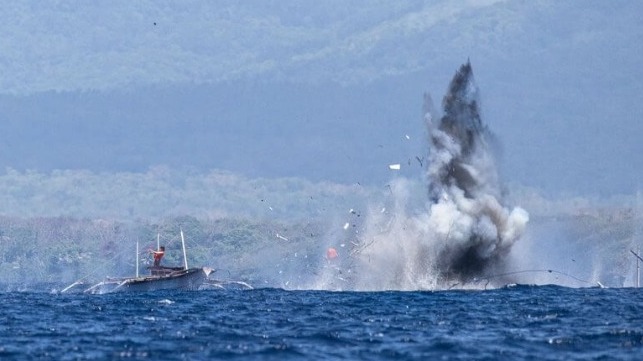U.S. Special Ops Gunship Decimates Fishing Boats in South China Sea Test

U.S. military units are training alongside Philippine forces in the South China Sea this month, preparing for a range of maritime security and shore defense scenarios. Some elements have caught the attention of the Chinese government, like amphibious exercises aimed at retaking and holding islands from a hostile force in the Philippine exclusive economic zone. At least one of these exercises might be applied to countering China's maritime militia - the force of hundreds of government funded commercial trawlers that provide a constant Chinese presence in Philippine waters. In a little-publicized trial, U.S. Special Operations Command dispatched an AC-130J Ghostrider gunship for a sinking exercise targeting small fishing vessels.
Developed during the Vietnam War for close air support, the AC-130 is a conventional cargo plane bristling with heavy weapons. The basic airframe remains the same as it was nearly 60 years ago, but the latest version has an extended range, advanced electronics, a 105mm howitzer in a specially-designed recoil carriage and a 30mm chain gun. It can also deliver a variety of small bombs and missiles from external weapons pylons.
For the test, exercise organizers used several outrigger fishing boats of a traditional Philippine design (bangka boats). The AC-130J's ordnance - designed for destroying hardened targets on shore - functioned as intended.
Watch an AC-130J Ghostrider gunship aircraft of the #USAF's 27th SOW hunting boats during exercise #Balikatan2024 of the Philippines Armed Forces. Soon or late, these AC-130Js can hunt Chinese Coast Guard vessels during any possible maritime conflict with #China. pic.twitter.com/yYZiTZ1v4B
— Babak Taghvaee - The Crisis Watch (@BabakTaghvaee1) May 2, 2024
By treaty, the U.S. is obligated to defend the Philippines in the event of an attack, including an attack on its vessels or military personnel. Over the past two years, China's maritime militia and coast guard have been edging up towards this threshold, and their rules of engagement in the South China Sea have become increasingly confrontational. Escalatory new tactics include shining powerful target illumination lasers at Philippine vessels; swarming and blocking maneuvers; shouldering; installing rope barriers; and water-cannoning. Multiple Philippine personnel have been injured in water-cannon attacks, and at least four vessels have been damaged by high-pressure streams.
Last week, China Coast Guard cutters water-cannoned two Philippine patrol vessels with more force than in previous encounters. Damage included bent railings, torn deck canopies, interior flooding, and a broken radar and radome, reporters embedded in the mission said.
China claims sovereignty over the vast majority of the South China Sea, including waters and land features located hundreds of miles from the Chinese mainland. Most of these areas are within the EEZs of neighboring countries, including the Philippines. In 2016, an international tribunal ruled that China's claims to ownership of Philippine waters were invalid under international law; China denounced the ruling as a "piece of paper" and has ignored it.
The longstanding diplomatic dispute over the Philippine EEZ also has a new wrinkle. Last week, Chinese officials claimed that they reached a secret verbal agreement with the administration of former Philippine President Rodrigo Duterte in 2016. Beijing has hinted at a gentleman's agreement before, but this is the first time that officials have described it in detail. The purported agreement allowed Philippine fishermen to access Chinese-claimed areas of Philippine waters, so long as Philippine military vessels stayed out of the Philippines' western EEZ.
Current Philippine President Ferdinand Marcos Jr. has denied that such a deal ever existed, and has dispatched government vessels where needed to maintain a sovereign presence. His decision to carry out patrols and operations in Philippine waters "is the basic reason for the ceaseless disputes at sea between China and the Philippines over the past year and more,” the Chinese Embassy in Manila said in a statement.
